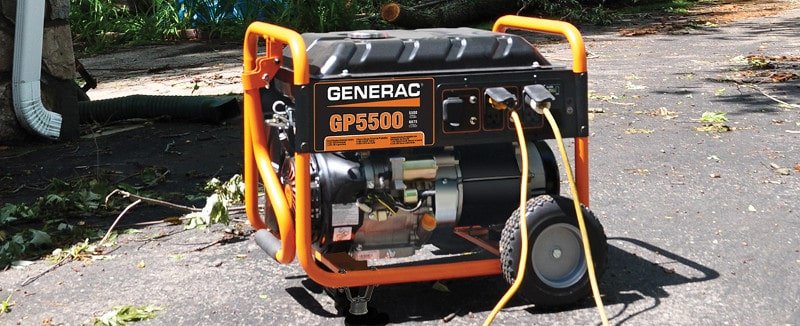Here you are again—rummaging through your garage for your portable generator. A hurricane will be bearing down in just a matter of hours, but just when you go to fire your backup power source up… nothing! The generator won’t start.
The next hurricane or tropical storms hits southwest Florida, don’t be stuck with a broken generator. Proper generator maintenance is essential if you want to avoid panicked maintenance calls and unneeded, last-minute stress.
Keep your portable generator running strong with these seven maintenance tips:
1. Run your portable generator every few months.
Just like humans, generators need to get a little exercise every once in a while. Electrical experts agree that running your generator every few months will keep the electric starter’s battery fresh and charged.
Since you won’t need to scramble around finding a way to charge your battery, a quick generator wake-up call will save you valuable time when the storm hits. Before firing up your dusty portable generator, make sure it’s outside in a well-ventilated area to avoid breathing in harmful fumes.
2. Routinely check the fuel in your portable generator.
Chances are you only use your portable generator a couple times every year, if even that often! In the interim, don’t make the mistake of leaving old gasoline sitting in the generator’s fuel tank. To prevent stale fuel, either add a fuel stabilizer to the tank, or empty the remaining gas at least once a year. We don’t recommend letting oil just sit in the tank between fire ups either; instead, fill it with fresh gasoline right before the next storm hits.
In addition, although the typical shelf life of oil in your generator is about five years for most brands, the exact amount of time it takes for gas to go stale is still up for debate— so don’t take the risk of clogging your generator engine with rank oil.
3. Check your fuel lines.
With time and usage, your portable generator’s fuel lines can become cracked, torn, or clogged. This can prevent the supply of gas from reaching the fuel system and cause your generator to not start or run efficiently.
While you can do some DIY work to clear a clogged fuel line, it’s often easier and more reassuring to simply replace a worn or problematic fuel line— especially because they’re sold in many sizes and are often pretty cheap.
4. Stock up on extra oil.
Powering your refrigerator and stove is hard on your generator’s oil! If you’re running that beast hard, you’ll need to change your oil frequently. Since you can expect to change the oil every 50 hours (only 25 hours for the first oil change), keep an ample supply of oil in your garage. With a sufficient supply, you’ll never have to worry about being in the dark when the storm rolls through.
5. Replace or clean that dirty air filter.
Most experts will say that if an air filter looks dirty, ditch it for a new one. This is solid advice, as the thin mess of these filters can really wear down with time and use. If it rips or becomes damaged, this could mean real bad news for your generator if left neglected.
If you do decide to clean your generator’s air filter instead of replacing it, use caution to avoid tearing the filter. Wash in soapy water and dry gently with a clean cloth or allow 24 hours to air-dry completely before inserting back into your unit. Much like generator fuel lines, air filters are relatively cheap— so if you were to ask us, we’d advise just replacing the thing to avoid future problems.
Some generators actually have fuel filters too. Check out our other blog, DIY Portable Generator Repair Tips, for steps on replacing your fuel filter.
6. Check in on your spark plugs.
A relatively common reason portable generators won’t start is because of a bad spark plug. Either the plug is dirty, compromising its connection, or it could be on its last leg and have trouble igniting. Either way, if the plug isn’t creating an arc of electricity, your generator could be struggling to power up.
Make sure your engine has fully cooled before removing your plug and inspecting it. If it’s marred up, clean it with a wire brush and insert back into your generator with a torque wrench. When doing this yourself, be careful not to over-crank and strip the threads on your plug, which could compromise your connection or even break your porcelain insulator and cause damage to your engine. If the plug looks fine on the outside, try swapping it out for a new one and see if that helps.
Even if your generator isn’t experiencing problems and you’re just giving it a routine checkup, it might be time to replace the plug. As a general rule of thumb, if your air filter is dirty enough to need cleaning or replacement, it’s time to replace that spark plug too.
7. Invest in a long, heavy-duty extension cord.
It’s no secret, generators are loud! To cut down on noise, most people position their portable generator further away from the house. But as an extension cord increases in length or decreases in gauge, the amount of voltage it can carry diminishes. This could mean that your generator is working harder to transmit less power, and have extra unnecessary wear on your unit over time. If you place your generator at distance, make sure you use a heavy duty 12-gauge cord, no longer than 100 feet.
Not sure the voltage requirements you need? Consult an electrical professional to find the right cord to power your particular voltage portable generator.
Maybe it’s Time for a Standby Generator?
While a portable generator is often less expensive, it’s much more inconvenient and can’t offer the same level of power and comfort that a permanently installed standby generator can.
Is it time to ditch the oil, the filters, the maintenance, and the toxic fumes for a standby? More Florida homeowners are using standbys vs. portable units because they can provide hassle-free power to major appliances and air conditioning when you lose power.
If you’re ready to start exploring home standby generators, we have the perfect guide for you. In our The Battle of the Home Standby Generator guide, we compare three of the top brands of home automatic generators, stacking similar models side-by-side to help you find a partial or full-home generator for your needs.
Download this free resource, today!



